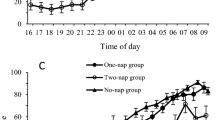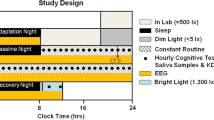Abstract
Older adults experience more fragmented sleep, greater daytime sleepiness and, nap more often than younger adults. Little research has investigated the effects of napping on waking function in older adults. In the present study, waking cognitive performance was examined in 10 young (mean age = 28 years), 10 middle-aged (mean age = 42 years) and 12 older adults (mean age = 61 years) following 60-min, 20-min and no nap conditions. It was expected that the older adults would need a longer nap to accrue benefits. Napping led to improvements for all age groups in subjective sleepiness, fatigue and accuracy on a serial addition/subtraction task. Waking electroencephalogram (EEG) confirmed that the participants were more physiologically alert following naps. There were no age differences in subjective reports or cognitive tasks; however, older adults had higher beta and gamma in the waking EEG, suggesting that they needed increased effort to maintain performance. Overall, older adults had smaller P2 amplitudes, reflecting their difficulty in inhibiting irrelevant stimuli, and delayed latencies and smaller amplitude P300s to novel stimuli, reflecting deficits in their frontal lobe functioning. Although older adults did garner benefits from napping, there was no evidence that they required longer naps to experience improvement.
Similar content being viewed by others
References
Bonnet MH. The effect of varying prophylactic naps on performance, alertness and mood throughout a 52-hour continuous operation. Sleep 1991; 29: 831–40.
Takahashi M. The role of prescribed napping in sleep medicine. Sleep Med. Rev. 2003; 7: 227–35.
Brooks A, Lack LC. A brief afternoon nap following nocturnal sleep restriction: which nap duration is most recuperative? Sleep 2006; 25 (Abstract Suppl): A402.
Lumley M, Roehrs T, Zorick F et al. The alerting effects of naps in sleep-deprived subjects. Psychophysiology 1986; 23: 403–8.
Tietzel AJ, Lack LC. The short-term benefits of brief and long naps following nocturnal sleep restriction. Sleep 2001; 24: 293–300.
Tietzel AJ, Lack LC. The recuperative value of brief and ultra-brief naps on alertness and cognitive performance. J. Sleep Res. 2002; 11: 213–18.
Dinges DF. Sleep inertia. In: Carskadon MA, Rechtschaffen A, Richardson G et al., eds. Encyclopedia of Sleep and Dreaming. Toronto: Maxwell Macmillan Canada, 1993; 553–4.
Hayashi M, Watanabe M, Hori T. The effects of a 20 min nap in the mid-afternoon on mood, performance and EEG activity. Clin. Neurophysiol. 1999; 110: 272–9.
Hayashi M, Hori T. The effects of a 20-min nap before post-lunch dip. Psychiatry Clin. Neurosci. 1998; 52: 203–4.
Hayashi M, Ito S, Hori T. The effects of a 20-min nap at noon on sleepiness, performance and EEG activity. Int. J. Psychophysiol. 1999; 32: 173–80.
Milner CE, Fogel SM, Cote KA. Habitual napping moderates motor performance improvements following a short daytime nap. Biol. Psychol. 2006; 73: 141–56.
Nader R, Smith C. A role for stage 2 sleep in memory processing. In: Maquet P, Smith C, Stickgold R, eds. Sleep and Brain Plasticity. Oxford: Oxford University Press, 2003; 87–100.
Fogel SM, Smith CT, Cote KA. Dissociable learning-dependent changes in REM and non-REM sleep in declarative and procedural memory systems. Behav. Brain Res. 2007; 180: 48–61.
Jacobs D, Ancoli-Israel S, Parker L et al. Twenty-four-hour sleep-wake patterns in a nursing home population. Psychol. Aging 1989; 4: 352–6.
Williams RL, Karacan I, Thornby JI et al. The electroencephalogram sleep patterns of middle-aged males. J. Nerv. Ment. Dis. 1972; 154: 22–30.
Darchia N, Campbell IG, Feinberg I. Rapid eye movement density is reduced in the normal elderly. Sleep 2003; 26: 973–7.
Crowley K, Trinder J, Kim Y et al. The effects of normal aging on sleep spindle and K-complex production. Clin. Neurophysiol. 2002; 113: 1615–22.
Carskadon MA, Dement WC. Sleep loss in elderly volunteers. Sleep 1985; 8: 207–21.
Carrier J, Land S, Buysse DJ et al. The effects of age and gender on sleep EEG power spectral density in the middle years of life (ages 20–60 years old). Psychophysiology 2001; 38: 232–42.
Campbell IG, Feinberg I. Homeostatic sleep response to naps is similar in normal elderly and young adults. Neurobiol. Aging 2005; 26: 135–44.
Vitiello MV. Sleep disorders and aging: understanding the causes. J. Gerontol. 1997; 52A: M189–M191.
Monk TH, Buysse DJ, Carrier J et al. Effects of afternoon “siesta” naps on sleep, alertness, performance, and circadian rhythms in the elderly. Sleep 2001; 24: 680–7.
Beh HC. A survey of daytime napping in an elderly Australian population. Aust. J. Psychol. 1994; 46: 100–6.
Ohayon MM, Zulley J. Prevalence of naps in the general population. Sleep Hypn. 1999; 1: 88–97.
National Sleep Foundation 2003 Sleep in America Poll. [Cited 8 Sept 2003.] Available from URL: http://www.sleepfoundation.org
Ohayon MM, Vecchierini MF. Normative sleep data, cognitive function and daily living activities in older adults in the community. Sleep 2005; 28: 981–9.
Ancoli-Israel S, Kripke DF. Prevalent sleep problems in the aged. Biofeedback and Self-Regulation 1991; 16: 349–59.
Hays JC, Blazer DG, Foley DJ. Risk of napping: excessive daytime sleepiness and mortality in an older community population. J. Am. Geriatr. Soc. 1996; 44: 693–8.
Hoch CC, Dew MA, Reynolds CF et al. Longitudinal changes in diary- and laboratory-based sleep measures in health “old old” and “young old” participants: a three-year follow-up. Sleep 1997; 20: 192–202.
Haimov I, Lavie P. Circadian characteristics of sleep propensity function in healthy elderly: a comparison with young adults. Sleep 1997; 20: 294–300.
Tamaki M, Shirota A, Hayashi M et al. Restorative effects of a short afternoon nap (<30 min) in the elderly on subjective mood, performance and EEG activity. Sleep Res. Online 2000; 3: 131–9.
Tamaki M, Shirota A, Tanaka H et al. Effects of a daytime nap in the aged. Psychiatry Clin. Neurosci. 1999; 53: 273–5.
Campbell SS, Murphy PJ, Stauble TN. Effects of a nap on nighttime sleep and waking function in older subjects. J. Am. Geriatr. Soc. 2005; 53: 48–53.
Rabbitt P. Frontal brain changes and cognitive performance in old age. Cortex 2005; 41: 238–40.
Tisserand DJ, Jolles J. On the involvement of prefrontal networks in cognitive ageing. Cortex 2003; 39: 1107–28.
West RL. An application of prefrontal cortex function theory to cognitive aging. Psychol. Bull. 1996; 120: 272–92.
Horne J. Human sleep, sleep loss and behaviour. Br. J. Psychiatry 1993; 162: 413–19.
Chee MW, Choo WC. Functional imaging of working memory after 24 hr of total sleep deprivation. J. Neurosci. 2004; 24: 4560–7.
Yositake H. Three characteristics patterns of subjective fatigue symptoms. Ergonomics 1978; 21: 231–3.
Horne J, Ostberg O. A self-assessment questionnaire to determine morningness-eveningness. Int. J. Chronobiol. 1976; 4: 97–110.
International Personality Item Pool. A scientific collaboratory for the development of advanced measures of personality traits and other individual differences. international personality item pool. [Cited 9 April 2003.] Available from URL: http://ipip.ori.org
Beck AT, Ward CH, Mendelson M et al. An inventory for measuring depression. Arch. Gen. Psychiatry 1961; 4: 561–71.
Wechsler D. Wechsler Adult Intelligence Scale, 3rd edn. Toronto, ON: Harcourt Brace Co., 1997.
McNair D, Lorr M, Droppleman LF. Profile of Mood States: San Diego, CA: Educational & Industrial Test Services. 1971.
Stampi C, Stone P, Michimori A. A new quantitative method for assessing sleepiness: the Alpha Attenuation Test. Work Stress 1995; 9: 368–76.
Fabiani M, Kazmerski VA, Cycowicz YM et al. Naming norms for brief environmental sounds: effects of age and dementia. Psychophysiology 1996; 33: 462–75. Sounds retrieved 17 July 2003. Available from URL: http://cepl.cpmc.columbia.edu/Resources/Auditory_Stimuli/auditory_stimuli.html
Hoddes E, Zarcone V, Smythe H et al. Quantification of sleepiness: a new approach. Psychophysiology 1973; 10: 431–6.
Rechtschaffen A, Kales A. A Manual of Standardized Terminology, Techniques, and Scoring System for Sleep Stages of Human Subjects. Washington, DC: National Institute of Health Publishing 204, US Government Printing Office, 1968.
Valley V, Broughton R. The physiological (EEG) nature of drowsiness and its relation to performance deficits in narcoleptics. Electromyogr. Clin. Neurophysiol. 1983; 55: 243–51.
Cote KA, de Lugt DR, Langley SD et al. Scalp topography of the auditory evoked K-complex in stage 2 and slow wave sleep. J. Sleep Res. 1999; 8: 263–72.
Colrain IM, Webster KE, Hirst G. The N550 component of the evoked K-complex: a modality non-specific response? J. Sleep Res. 1999; 8: 273–80.
Picton TW, Lins OG, Scherg M. The recording and analysis of event-related potentials. In: Boller F, Graftman J, eds. Handbook of Neuropsychology, Vol. 10. Amsterdam: Elsevier Science BV, 1995; 3–73.
Colrain IM. The K-complex: a 7-decade history. Sleep 2005; 28: 255–73.
Cote KA, Epps T, Campbell KB. The role of the spindle in human information processing of high intensity stimuli during sleep. J. Sleep Res. 2000; 9: 19–26.
Ackerman PT, McPherson WB, Oglesby DM et al. EEG power spectra of adolescent poor readers. J. Learn. Disabil. 1998; 31: 83–90.
Crowley K, Colrain I. A review of the evidence for P2 being an independent component process: age, sleep and modality. Clin. Neurophysiol. 2004; 115: 732–44.
Fjell AM, Walhovd KB. Life-span changes in P3a. Psychophysiology 2004; 41: 575–83.
Näätänen R, Picton T. The N1 wave of the human electric and magnetic response to sound: a review and an analysis of the component structure. Psychophysiology 1987; 24: 375–425.
Näätänen R. The role of attention in auditory information processing as revealed by event-related potentials and other brain measures of cognitive function. Behav. Brain Sci. 1990; 13: 201–88.
Cajochen C, Brunner DP, Krauchi K et al. Power density in theta/alpha frequencies of the waking EEG progressively increases during sustained wakefulness. Sleep 1995; 18: 890–4.
Tanaka H, Shirakawa S. Sleep health, lifestyle and mental health in the Japanese elderly: ensuring sleep to promote a healthy brain and mind. J. Psychosom. Res. 2004; 56: 465–77.
Author information
Authors and Affiliations
Corresponding author
Rights and permissions
About this article
Cite this article
Milner, C.E., Cote, K.A. A dose-response investigation of the benefits of napping in healthy young, middle-aged and older adults. Sleep Biol. Rhythms 6, 2–15 (2008). https://doi.org/10.1111/j.1479-8425.2007.00328.x
Received:
Accepted:
Published:
Issue Date:
DOI: https://doi.org/10.1111/j.1479-8425.2007.00328.x




